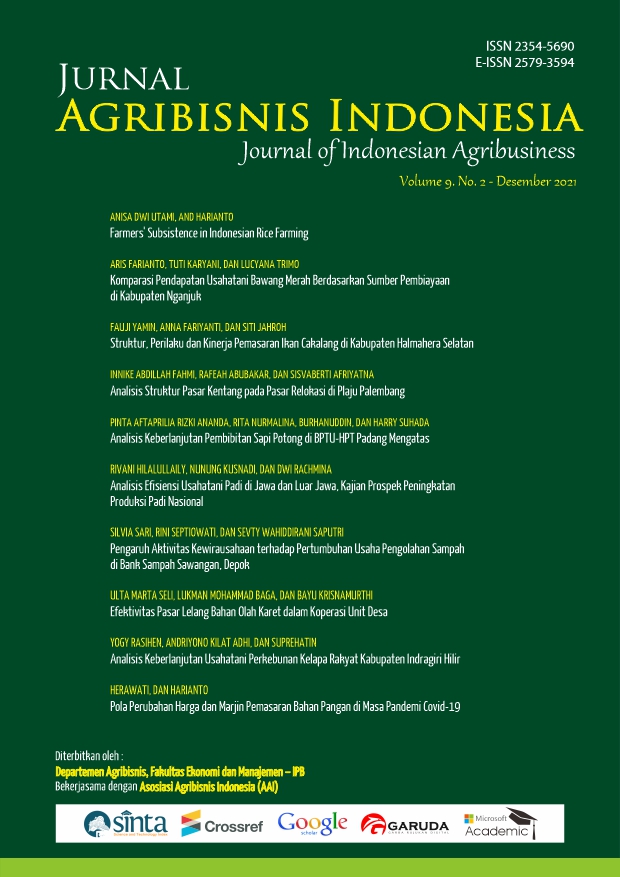Analisis Efisiensi Usahatani Padi di Jawa dan Luar Jawa: Kajian Prospek Peningkatan Produksi Padi Nasional
Isi Artikel Utama
Abstrak
Padi dapat tumbuh di hampir seluruh pulau di Indonesia, tetapi 57 persen padi di produksi di Pulau Jawa, dengan luasan kurang dari 10 persen dari total luasan di Indonesia. Studi mengenai prospek peningkatan produksi padi nasional penting dilakukan sebagai antisipasi meningkatnya konsumsi beras, terkhusus dengan memanfaatkan lahan di luar Pulau Jawa. Tujuan penelitian ini yaitumengidentifikasi prospek peningkatan produksi beras nasional, terutama di luar Jawa, dari perspektif faktor produksi padi dan efisiensin teknis ditingkat petani. Dengan menggunakan stochastic frontier, fungsi produksi translog menunjukan bahwa peningkatan input (lahan, benih, pupuk dan pestisida) tidak banyak meningkatkan produksi padi di Pulau Jawa dan luar Pulau Jawa (inelastis), sedangkan tenaga kerja bertanda negatif. Berdasarkan hasil efisiensi teknis, potensi petani untuk meningkatkan produksi padi di Jawa dan luar Jawa sebesar 28 dan 39 persen. Selain itu, analisis menunjukan irigasi, status lahan, kelompok tani dan pendidikan petani memengaruhi efisiensi teknis. Penelitian ini dapat disimpukan bahwa prospek peningkatkan produksi padi dengan efisiensi teknis di luar Pulau Jawa lebih tinggi daripada di Pulau Jawa. Namun, peningkatan produksi padi di luar Pulau Jawa dapat dilakukan dengan membangun lahan irigasi. Selain itu, untuk meningkatkan produksi padi secara signifikan diperlukannya teknologi produksi padi baru baik di Jawa dan luar Jawa.
Unduh
Rincian Artikel
Jurnal Agribisnis Indonesia (JAI) is an Open Access Journal. The authors who publish the manuscript in this journal agree to the following terms:
Creative Commons License
JAI is licensed under a Creative Commons Attribution 4.0 International License. This permits anyone to copy, redistribute, remix, transmit, and adapt the work provided the original work and source are appropriately cited.
This means:
(1) Under the CC-BY license, authors retain ownership of the copyright for their article, but authors grant others permission to use the content of publications in Jurnal Agribisnis Indonesia in whole or in part provided that the original work is properly cited. Users (redistributors) of JAI are required to cite the original source, including the author's name, JAI as the initial source of publication, year of publication, volume number, issue, and Digital Object Identifier (DOI); (2) Authors grant JAI the right of first publication. Although authors remain the copyright owner.
Referensi
[BPS] Badan Pusat Statistika. 2017. Kajian Konsumsi Bahan Pokok 2018. Jakarta: Badan Pusat Statistika.
[BPS] Badan Pusat Statistika. 2018. Hasil Survei Pertanian Antar Sensus (SUTAS) 2018. Jakarta: Badan Pusat Statistika.
[BPS] Badan Pusat Statistika. 2019a. Perkembangan Beberapa Indikator Utama Sosial-Ekonomi Indonesia. Jakarta: Badan Pusat Statistika.
[BPS] Badan Pusat Statistika. 2019b. Luas panen dan produksi padi di Indonesia 2019 No. 16/02/Th. XXIII. https://www.bps.go.id/website/images/KSA-2019-ind.jpg. [4 Juni 2020]
[BPS] Badan Pusat Statistika. 2019c. Nilai produksi dan biaya produksi per musim tanam per hektar budidaya tanaman padi sawah, padi ladang, jagung dan kedelai, 2017. https://www.bps.go.id/statictable/2019/04/10/2055/nilai-produksi-dan-biaya-produksi-per-musim-tanam-per-hektar-budidaya-tanaman-padi-sawah-padi-ladang-jagung-dan-kedelai-2017.html. [4 Juni 2020].
Christensen LR, Jorgenson DW, Lau LJ. 1973. Transcendental Logarithmic Production Frontiers. The review of economics and statistics. 55(1): 28-45.
Coelli TJ, Rao DSP, O’Donnell CJ, Battese GE. 2005. An Introduction to Efficiency and Productivity Analysis Second Edition. New York: Spinger Science and Business Media.
Heriqbaldi U, Purwono R, Haryanto T, Primanthi MR. 2015. An Analysis Of Technical Efficiency Of Rice Production In Indonesia. Asian Social Science. 11(3): 91 – 102
Junaedi M. 2016. Efisiensi dan kesenjangan teknologi usahatani padi sawah di Indonesia: analisis meta-frontier [disertasi]. Bogor: Institut Pertanian Bogor.
Kusnadi N, Tinaprilla N, Susilowati SH, Purwoto A. 2011. Analisis Efisiensi Usahatani Padi Di Beberapa Sentra Produksi Padi Di Indonesia. Jurnal Agro Ekonomi. 29 (1):25 – 46.
Mulyani A, Kuncoro D, Nursyamsi D, Agus F. 2016. Analisis Konversi Lahan Sawah: Penggunaan Data Spasial Resolusi Tinggi Memperlihatkan Laju Konversi Yang Mengkhawatirkan. Jurnal Tanah dan Iklim. 40(2): 121-133.
Mulyani A, Nursyamsi D dan Syakir M. 2017. Strategi Pemanfaatan Sumberdaya Lahan Untuk Pencapaian Beras Berkelanjutan. Jurnal Sumberdaya Lahan. 11(1): 11-22.
Novitaningrum R, Supardi S, Marwanti S. 2019. Efisiensi Teknis Pengelolaan Tanaman Terpadu Padi Sawah Di Kabupaten Karanganyar, Provinsi Jawa Tengah. Jurnal Agro Ekonomi. 37(2): 123-140.
Ouedraogo S. 2015. Technical And Economic Efficiency Of Rice Production In The Kou Valley (Burkina Faso): Stochastic Frontier Approach. Asian Journal of Agriculture and Rural Development. 5(2):53-63.
[Pusdatin] Pusat Data dan Sistem Informasi Pertanian. 2018. Statistik Sarana Pertanian Tahun 2018. Jakarta: Pusat Data dan Sistem Informasi Pertanian Sekretariat Jenderal - Kementerian Pertanian.
Rahman KMM, Mia MI, Alam MA. 2012. Farm Size Specific Technical Efficiency: A Stochastic Frontier Analysis For Rice Growers In Bangladesh. Bangladesh J. Agric. Econs. 35(1&2): 131-142.
Sofyan A, Nurjana, Kasno A. 2005. Status hara tanah sawah untuk rekomendasi pemupukan. http://balittanah.litbang.pertanian.go.id/ind/dokumentasi/buku/buku%20lahan%20sawah/03status_hara.pdf

